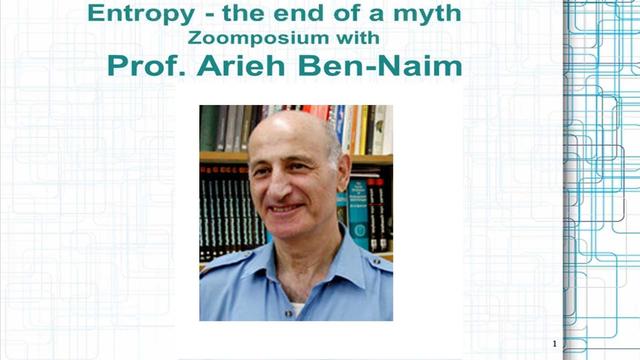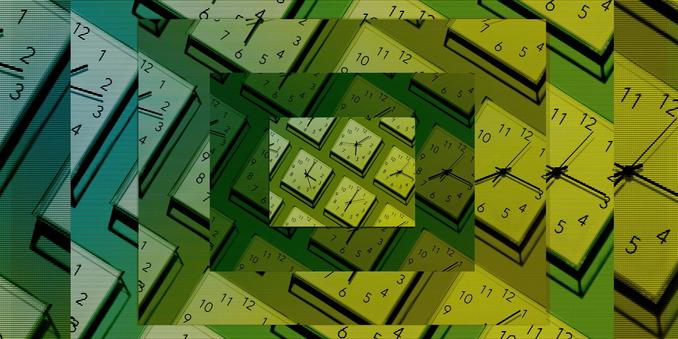Mashable: ‘Was 1995 30 years ago?’ Google’s AI overviews is having issues with a simple question . “People online noticed Google’s AI Overviews seemed to have trouble with this particular query. It became almost a trend of sorts to ask, ‘Was 1995 30 years ago?’ Lots of people posted screenshots appearing to show Google answering with incorrect answers — typically speaking, AI Overviews […]
Zoomposium with Prof. Dr. Arieh Ben-Naim: “Demystifying Entropy”
He believes that we need a new fundamental understanding of the phenomenon of entropy. Entropy, which originally stems from the second law of thermodynamics, has, in Arieh's view, been misused and incorrectly transferred as a concept to other areas of physics, biology, and everyday life.
More on this at:https://open.spotify.com/episode/6l0bnl0eU0CUqmAEo8DZf7?si=wJ2EEsQ6QK2HjZMTVGsJZw
or: https://philosophies.de/index.php/2024/02/22/entzauberung-der-entropie/
#Science #Philosophy #PhysicsAndItsLimits #ScienceAndPhilosophy #entropyzero2 #InformationTheory #SecondLawOfThermodynamics #LimitsOfPhysics #Entropy #SecondLaw #Irreversibility #StatisticalMechanics #Thermodynamics #ShannonInformation #Probability #Randomness #Time #ArrowOfTime #Metaphysics #LifeSystems #Evolution #Negentropy #AriehBenNaim #EntropyDemystified #PhysicsMyths
The Limits of NTP Accuracy on Linux
https://scottstuff.net/posts/2025/05/19/ntp-limits/
#HackerNews #NTP #Accuracy #Linux #Limits #Time #Synchronization #Technology

The Limits of NTP Accuracy on Linux
Lately I’ve been trying to find (and understand) the limits of time syncing between Linux systems. How accurate can you get? What does it take to get that? And what things can easily add measurable amounts of time error? After most of a month (!), I’m starting to understand things. This is kind of a follow-on to a previous post, where I walked through my setup and goals, plus another post where I discussed time syncing in general. I’m trying to get the clocks on a bunch of Linux systems on my network synced as closely as possible so I can trust the timestamps on distributed tracing records that occur on different systems. My local network round-trip times are in the 20–30 microsecond (μS) range and I’d like clocks to be less than 1 RTT apart from each other. Ideally, they’d be within 1 μS, but 10 μS is fine. It’s easy to fire up Chrony against a local GPSTechnically, GNSS, which covers multiple satellite-backed navigation systems, not just the US GPS system, but I’m going to keep saying “GPS” for short. -backed time source and see it claim to be within X nanoseconds of GPS, but it’s tricky to figure out if Chrony is right or not. Especially once it’s claiming to be more accurate than the network’s round-trip time20 μS or so. , the amount of time needed for a single CPU cache miss50-ish nanoseconds. , or even the amount of time that light would take to span the gap between the server and the time source.About 5 ns per meter. I’ve spent way too much time over the past month digging into time, and specifically the limits of what you can accomplish with Linux, Chrony, and GPS. I’ll walk through all of that here eventually, but let me spoil the conclusion and give some limits: GPSes don’t return perfect time. I routinely see up to 200 ns differences between the 3 GPSes on my desk when viewing their output on an oscilloscope. The time gap between the 3 sources varies every second, and it’s rare to see all three within 20 ns of each other. Even the best GPS timing modules that I’ve seen list ~5 ns of jitter on their datasheets. I’d be surprised if you could get 3-5 GPS receivers to agree within 50 ns or so without careful management of consistent antenna cable length, etc. Even small amounts of network complexity can easily add 200-300 ns of systemic error to your measurements. Different NICs and their drivers vary widely on how good they are for sub-microsecond timing. From what I’ve seen, Intel E810 NICs are great, Intel X710s are very good, Mellanox ConnectX-5 are okay, Mellanox ConnectX-3 and ConnectX-4 are borderline, and everything from Realtek is questionable. A lot of Linux systems are terrible at low-latency work. There are a lot of causes for this, but one of the biggest is random “stalls” due to the system’s SMBIOS running to handle power management or other activities, and “pausing” the observable computer for hundreds of microseconds or longer. In general, there’s no good way to know if a given system (especially cheap systems) will be good or bad for timing without testing them. I have two cheap mini PC systems that have inexplicably bad time syncing behavior,1300-2000 ns. and two others with inexplicably good time syncing20-50 ns . Dedicated server hardware is generally more consistent. All in all, I’m able to sync clocks to within 500 ns or so on the bulk of the systems on my network. That’s good enough for my purposes, but it’s not as good as I’d expected to see.
https://scottstuff.net/posts/2025/05/19/ntp-limits/
#ycombinator #ntp #time #benchmarking

The Limits of NTP Accuracy on Linux
Lately I’ve been trying to find (and understand) the limits of time syncing between Linux systems. How accurate can you get? What does it take to get that? And what things can easily add measurable amounts of time error? After most of a month (!), I’m starting to understand things. This is kind of a follow-on to a previous post, where I walked through my setup and goals, plus another post where I discussed time syncing in general. I’m trying to get the clocks on a bunch of Linux systems on my network synced as closely as possible so I can trust the timestamps on distributed tracing records that occur on different systems. My local network round-trip times are in the 20–30 microsecond (μS) range and I’d like clocks to be less than 1 RTT apart from each other. Ideally, they’d be within 1 μS, but 10 μS is fine. It’s easy to fire up Chrony against a local GPSTechnically, GNSS, which covers multiple satellite-backed navigation systems, not just the US GPS system, but I’m going to keep saying “GPS” for short. -backed time source and see it claim to be within X nanoseconds of GPS, but it’s tricky to figure out if Chrony is right or not. Especially once it’s claiming to be more accurate than the network’s round-trip time20 μS or so. , the amount of time needed for a single CPU cache miss50-ish nanoseconds. , or even the amount of time that light would take to span the gap between the server and the time source.About 5 ns per meter. I’ve spent way too much time over the past month digging into time, and specifically the limits of what you can accomplish with Linux, Chrony, and GPS. I’ll walk through all of that here eventually, but let me spoil the conclusion and give some limits: GPSes don’t return perfect time. I routinely see up to 200 ns differences between the 3 GPSes on my desk when viewing their output on an oscilloscope. The time gap between the 3 sources varies every second, and it’s rare to see all three within 20 ns of each other. Even the best GPS timing modules that I’ve seen list ~5 ns of jitter on their datasheets. I’d be surprised if you could get 3-5 GPS receivers to agree within 50 ns or so without careful management of consistent antenna cable length, etc. Even small amounts of network complexity can easily add 200-300 ns of systemic error to your measurements. Different NICs and their drivers vary widely on how good they are for sub-microsecond timing. From what I’ve seen, Intel E810 NICs are great, Intel X710s are very good, Mellanox ConnectX-5 are okay, Mellanox ConnectX-3 and ConnectX-4 are borderline, and everything from Realtek is questionable. A lot of Linux systems are terrible at low-latency work. There are a lot of causes for this, but one of the biggest is random “stalls” due to the system’s SMBIOS running to handle power management or other activities, and “pausing” the observable computer for hundreds of microseconds or longer. In general, there’s no good way to know if a given system (especially cheap systems) will be good or bad for timing without testing them. I have two cheap mini PC systems that have inexplicably bad time syncing behavior,1300-2000 ns. and two others with inexplicably good time syncing20-50 ns . Dedicated server hardware is generally more consistent. All in all, I’m able to sync clocks to within 500 ns or so on the bulk of the systems on my network. That’s good enough for my purposes, but it’s not as good as I’d expected to see.
気持ちよさそうに寝っ転がる姿に癒やされる!『メイドインアビス 烈日の黄金郷』ナナチがバンプレストのフィギュアシリーズ「Relax time」に初登場!
https://hobby.dengeki.com/news/2689195/
#hobby_dengeki #バンプレスト #フィギュア #メイドインアビス #烈日の黄金郷 #ナナチ #プライズ #Relax #time
Welcome to the Paradox of Choice – the idea that having too many options can actually make decision-making harder, not easier.
Read more 👉 https://lttr.ai/Adogb
Kansas City Chiefs making announcement Monday
The Kansas City Chiefs will be making an announcement Monday regarding a “significant” partnership with a local company.…
#NFL #KansasCityChiefs #KansasCity #Kansas #Chiefs #AndyReid #announce #announcement #announcementmonday #arrowhead #fewdetail #Football #GEHA #kc #kcchiefs #livestream #Local #localcompany #organization #p.m. #Partnership #PatrickMahomes #time
https://www.rawchili.com/nfl/317380/
When AI Sees Time Differently
What, exactly, is space-time? – The Conversation
Eternalism understands that everything, everywhere, exists atemporally and all at once. (Rick Rothenberg / Unsplash), CC BYWhat, exactly, is space-time?
Published: August 24, 2025 8:22am EDT
Author
Disclosure statement
Daryl Janzen does not work for, consult, own shares in or receive funding from any company or organization that would benefit from this article, and has disclosed no relevant affiliations beyond their academic appointment.
University of Saskatchewan provides funding as a founding partner of The Conversation CA.
Different approaches to understanding what space-time is help us understanding our reality. (Jeremy Thomas / Unsplash)University of Saskatchewan provides funding as a member of The Conversation CA-FR.
Few ideas in modern science have reshaped our understanding of reality more profoundly than space-time — the interwoven fabric of space and time at the heart of Albert Einstein’s theory of relativity.
Space-time is frequently described as the “fabric of reality.” In some accounts, this fabric is referred to as a fixed, four-dimensional “block universe” — a complete map of all events, past, present and future.
In others, it’s a dynamic field that bends and curves in response to gravity. But what does it really mean to say that space-time exists? What kind of thing is it — is space-time structure, substance or metaphor?
The heart of modern physics
These questions aren’t just philosophical. They sit at the heart of how we interpret modern physics and quietly shape everything from how we understand general relativity to how we imagine time travel, multiverses and our origins.
These questions inform the emergence of space-time itself and radical new proposals that treat it as the universe’s memory. And yet the language we use to describe space-time is often vague, metaphorical and deeply inconsistent.
Read more: Why do metaphors of space help us understand time?
Austrian-British philosopher Ludwig Wittgenstein once warned that philosophical problems arise when “language goes on holiday.” Physics, it turns out, may be a prime example.
Over the last century, familiar words such as “time,” “exist” and “timeless” have been repurposed in technical contexts without examining what baggage they carry from everyday speech.
This has led to widespread confusion about what these terms actually mean.
Austrian-British philosopher Ludwig Wittgenstein once warned that philosophical problems arise when “language goes on holiday.” Physics, it turns out, may be a prime example.
Over the last century, familiar words such as “time,” “exist” and “timeless” have been repurposed in technical contexts without examining what baggage they carry from everyday speech.
This has led to widespread confusion about what these terms actually mean.
Continue/Read Original Article Here: What, exactly, is space-time?
#2025 #Books #Education #History #Libraries #Opinion #Philosophy #Physics #Reading #Science #SpaceTime #TheConversation #Time


 Hacker News
Hacker News





